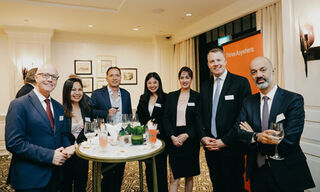Jane Fraser: «Globalization Isn’t Vanishing; It’s Changing»
During a speech at the recent APEC 2025 CEO Summit in South Korea, Citi chief executive Jane Fraser spoke about global trade and her confidence in continued collaboration between the US and Asia.
Citi’s chief executive officer Jane Fraser delivered a keynote address at the APEC 2025 CEO Summit in Gyeongju, South Korea, about the US-Asia trade corridor and the outlook ahead. While tariffs and other geopolitical tensions dominate headlines, she believes that collaboration between the US and the region remains well and alive.
«Globalization isn’t vanishing; it’s changing. Growth is becoming more balanced, more digital and more distributed. The APEC economies sit at the center of that change – together accounting for 61 percent of global GDP and over half of global trade,» said Fraser in the published speech.
«Since I last addressed APEC in 2023, we’ve seen a shift from reaction to reinvention. Back then, clients were reacting to shocks. Now, they’re investing for the long term — redesigning supply chains, digitizing operations and embedding resilience.»
Resilience in Trade
According to Fraser, there are three themes defining the rewiring of global trade. First is resilience, with the «ability to adjust and keep moving through uncertainty».
Based on Citi’s transaction data, trade volumes and payments are moving steadily across a more diverse mix of routes with supply chains becoming multi-hub networks instead of single corridors. This covers advanced manufacturing in the US and Mexico, energy and logistics in Canada, semiconductors in Korea and electronics in Malaysia.
«US-Asia trade remains one of the fastest growing corridors for our clients,» Fraser noted.
Innovation: Tech, Clean Energy and Digitalization
The second is innovation, underlined by an industrial era across APEC economies that is powered by technology, clean energy and digital connectivity.
According to the bank, more than $200 billion in private capital has flowed into frontier technologies across APEC with generative AI accounting for over half. Energy transition spending across APEC averages 2-3 percent of GDP annually with China leading via EV and battery exports. Digital infrastructure is also becoming prominent with data centers on the rise in Singapore and Malaysia, and fintech platforms scaling in the Philippines, Chile and Mexico.
«Together, APEC economies are forming a dynamic innovation loop: pairing North American R&D and venture capital with Asia’s manufacturing depth and speed. That partnership is delivering breakthroughs that benefit the world,» Fraser observed.
Broad-Based Growth
The third and final theme is broad-based growth with Asia’s rising middle class to account for two-thirds of global consumers by 2030, creating a new market for US exports and expansion opportunities for emerging economies.
«This is where APEC can lead: pairing world-class innovation and capital with deep production capability and a youthful consumer base across Asia and the Pacific,» Fraser added, highlighting that half of Citi’s new trade finance clients in Asia are small and medium-sized enterprises.
«In recent months, APEC members have announced hundreds of billions in planned investments in the US – a powerful signal of confidence in American enterprise and in the ties that bind this community together. Citi is proud to play a role in enabling that growth, linking capital with ideas, and ambition with opportunity.»



























